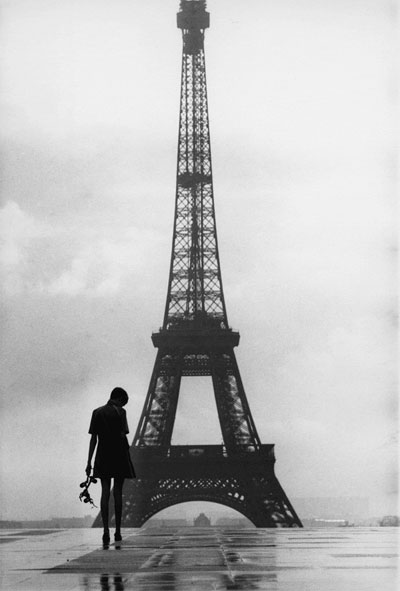
Facsimile Magazine, Published by Haoyan of America. Volume One, Number Three, 2007. ISSN 1937-2116.
Facsimile March 2007 ~ In A Word: Yes
Table of Contents

Facsimile Magazine, Published by Haoyan of America. Volume One, Number Three, 2007. ISSN 1937-2116.
Table of Contents

Lucrecia Roa is an artist and designer living in Los Angeles. She likes Paul Newman but believes in Steve McQueen.
By Eric Fredericksen From The July 1998 Issue Of Metropolis Magazine
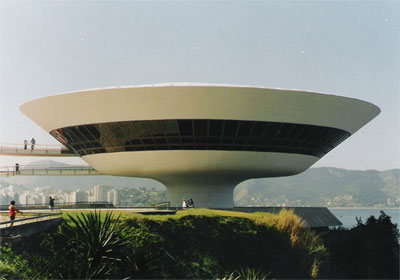
On a promontory on Guanabara Bay, facing Rio de Janeiro, rises a dramatic bloom of a building, the Museum of Contemporary Art in Niterói. With its gleaming white concrete surfaces and symmetrical, curving form mushrooming out above the rocky site, it seems like a well-preserved relic of Brazil's Fifties and Sixties boom, an example of optimistic high Modernism.
In fact, the museum was completed only last year, the latest work of the venerable Brazilian architect Oscar Niemeyer. Some visitors are surprised to learn that Niemeyer, who designed the major buildings for Brazil's master-planned capital, Brasília, is still active. His name has certainly fallen out of circulation in America, where he hasn't built anything since he worked with Le Corbusier and Wallace Harrison on the United Nations Headquarters. But Niemeyer is very much alive, and, in his nineties, has completed a building that shows his architectural gifts and his commitment to Modernism to be undimmed by age.
Unlike some of his contemporaries, Niemeyer never latched on to newer trends in order to keep his career going. Other than a spell in Europe in the late 1960s while Brazil was under military rule, he has pursued his craft here with little interruption or radical change, melding a personal love for curving forms with a high Modern-ist's belief in progress and liberation through technology. And Niemeyer's Modernism has always been tied to his native country; a formalist, his buildings often refer to the shapes of the Brazilian landscape, especially the curves of Rio's mountains and, he has said, her women.
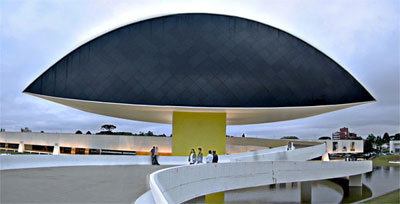
Rio, like Niemeyer, never repudiated Modernism. Though it took until 1930 for the movement to take off in Brazil, it has been the dominant aesthetic ever since. Its capital, built from scratch deep in the country's rural interior, has become an emblem of the style. And as it evolved in relative isolation, Modernism in Brazil took on a distinct and recognizable regionalism. "Every single formal motif [in Brazil] was charged with an emotive significance which enabled it to stand on its own," writes Leonardo Benevola in his 1960 History of Modern Architecture (MIT Press). "Composition became elementary, allusive... while the shape of the whole could be taken in at first glance."
When you walk the streets of Rio, you'll see no nonstructural, Post-Modern pilasters and cornices, no "ducks" or decorated sheds, no deconstructed cubes with their insides on the outside. What you will see are gems like A.E. Reidy's Pedregulho residential complex and the sweeping oval of Maracanã Stadium, as well as miles and miles of rectilinear apartment buildings, heavy on majolica tile and glass, steel and stucco, many set high on pilotis. The only pre-Modern buildings much in evidence are churches, though among them are some grand, Modern exceptions like the Metropolitan Cathedral, a stunning if somewhat brutal truncated cone of reinforced concrete.
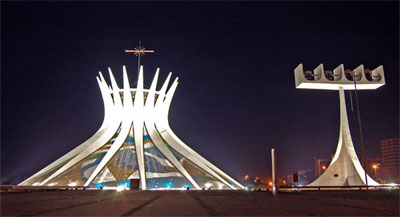
A similar aesthetic, on a much humbler scale, prevails in Niterói, a suburb of Rio connected by a long cantilever bridge. Home to some 500,000 people, it's known for great beaches and beautiful views of Rio, though not much else. In 1991, João Sattamini, a prominent art collector, gave the city a chance to change this. If Niterói would build a suitable venue, he would fill it with his extensive collection of contemporary Brazilian art. "Thinking big," then-mayor Jorge Roberto Silveira later wrote, "we immediately opted for Oscar Niemeyer."
After visiting the dramatic site, the architect quickly sketched out the design at a nearby restaurant. "I asked the waiter for a few sheets of paper," Silveira continued. "He was hurrying back with a few message slips when another waiter intercepted him and muttered, 'Bring bigger paper. This is the man who designed Brasília.' "
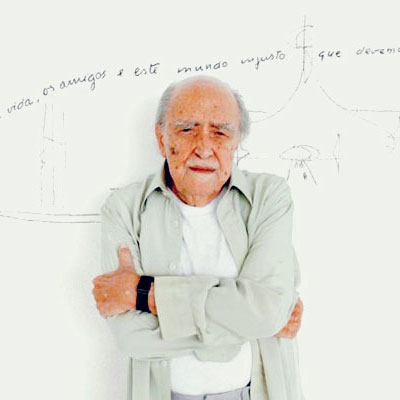
"My design sprang up spontaneously in the earliest sketches," Niemeyer remembered. "A central pillar, with the architecture floating free in space, like a flower." A narrow core set in the middle of a pool of water swoops out and then rises at a 40-degree angle to encompass the museum's offices and galleries. A deep red ramp makes a wide curve up to one floor, then twists around itself to ascend to a second entrance. Under a stone plaza and pool of water are spaces for a restaurant and auditorium. Children fish and swim in the bay below; their laughter can be heard inside the galleries.
Set on a high point that extends into the bay, the museum occupies the kind of site normally reserved for lighthouses; though rising only about 50 feet, the museum can be seen from all over Rio's waterfront and from the high mountains that jut up in the middle of the city. And the more one looks at this building, the more grace its flying saucer--like form assumes--particularly in the breathtaking moment when its side lines up with Sugarloaf Mountain, across the bay. By continuing to explore the Modernist aesthetic and refusing to depart from formalism and purity, Oscar Niemeyer has turned himself into an eccentric. But with this quirky, late work, he has created a building that is a beacon and a symbol of civic pride, a late blossom of Modernism.
By Tamir Ardon
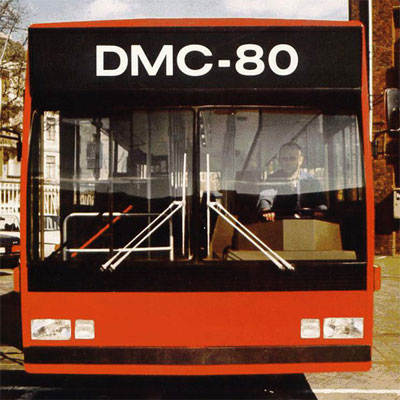
The DMC-80 is both a proven bus and a new bus. It is derived from the widely used VOV I standard bus (over 20,000 now in operation) and from the four year test of the VOV II, the prototype for the current experimental German model, the S 80.
These buses were cooperatively designed as a compromise between operators' needs and manufacturers' desires, in order to rapidly assure a new generation of acceptable buses without conflict. Their low floor, wide door concept was developed to enhance operations. The placement of components was designed to reduce operating costs. The high cost of fuel mandated a fuel efficient engine.
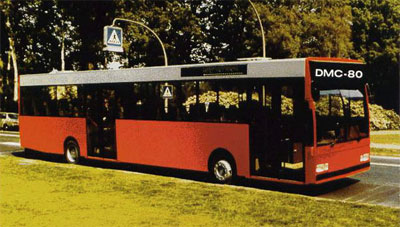
The DMC-80, in serial production, will be manufactured in the United States. It sets new standards for engineering excellence, innovation, reliability, passenger comfort, economical operation and ease of maintenance.
The De Lorean Motor Company - with support of our goals and concepts from the transit properties - is prepared to offer the U.S. market the first of a new generation of buses.
Ennio Morricone won an honorary Oscar at the 79th Academy Awards presentation on February 25, 2007, "for his magnificent and multifaceted contributions to the art of film music." Morricone has earned five Academy Award nominations but has not previously received an Oscar. Throughout his 45 year career he has scored over 400 films including the highly recognizable score for Sergio Leone's Buono, Il Brutto, Il Cattivo, Il (The Good, The Bad, and The Ugly).
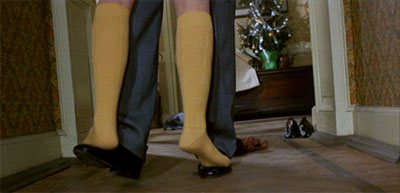
Please have a listen to some of Ennio Morricone's music:
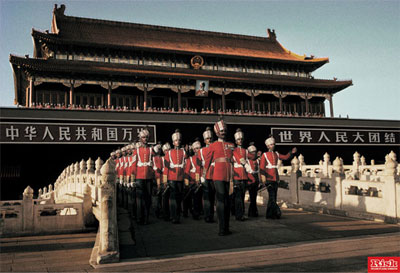
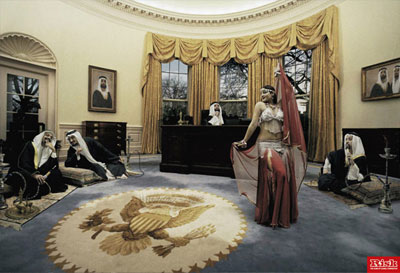
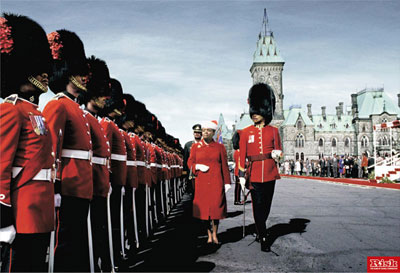
Saatchi & Saatchi, Sinapore's Ad Campaign for Hasbro's Risk: The Game of World Domination
By way of AdFreak
From Lia Cheyenne & Nick Lucking
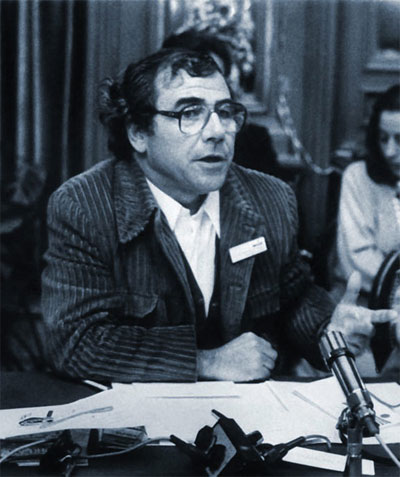
French philosopher, social theorist, and photographer Jean Baudrillard passed away at his home in Paris on March 6, 2007. Baudrillard is well known for his ideas about reality intertwining with fantasy and the concept of hyper-reality; suggesting that the world we live in has been replaced by a copy world, where we seek simulated stimuli and nothing more. Jean Baudrillard was 77 years old.
From Greenpeace
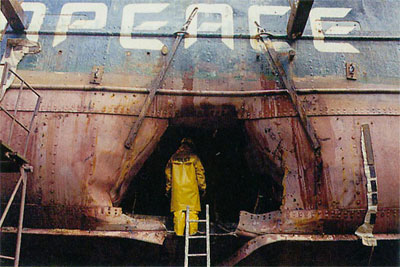
On the night of July 10, 1985 the Rainbow Warrior had been docked in Auckland harbour for three days while preparations for the protest voyage to the nuclear test site at Moruroa Atoll were finalised.
On board the Rainbow Warrior that night were several of the crew and a number of local Greenpeacers. Martini Gotje (first mate), skipper Pete Willcox, engineer Davey Edwards, Bene Hoffman, radio operator Lloyd Anderson, Rien Achterberg and Fernando Pereira were all having a drink in the ship's mess. Bunny McDiarmid was visiting relatives and Henk was at a meeting in the ship's theatre. All the skippers of the peace flotilla were there. Relief cook and peace squadroner Margaret Mills had baked a chocolate cake for Steve Sawyer's birthday. After the birthday celebration the assembled skippers met in the ship's theatre to discuss schedules and routes. Margaret, Pete and Lloyd were asleep in their cabins by 11:30 pm, all the others either departed or were up in the mess talking...
At 11:49 pm an electric blue flash was seen in the water beside the Warrior, quickly followed by a huge explosion. 'Bloody hell... It's from the engine room,' shouted Davey Edward after he was thrown from his chair against the wall. As everyone raced from the mess, Davey ran to the engine room. He was hardly able to open the door. It was like a huge steam bath, with water hissing in through the gaping hole torn in the ship's side.
Captain Pete Willcox, jolted awake, stumbled down to the engine room. One look was enough. 'Abandon ship, everyone get the hell out of here!' he shouted as the ship keeled over towards the wharf.
Fernando Pereira was worried about his cameras. He called out that he was going below to get them. He was quickly followed by Martini, who couldn't find his partner Hanne Sorensen and was worried she might still be in their cabin. The two men skidded down the stairs together. Martini checked out the cabin in scant seconds and made for the deck again, then the wharf. Fernando was in his cabin when the second blast went off, barely two minutes after the first.
There was panic on the wharf. No one had seen Fernando come back up. Martini was still asking, 'Where's Hanne?' Someone said they thought she's gone for a walk earlier.
Elaine Shaw (director of Greenpeace New Zealand) had just returned home from Piha when the telephone rang. It was a New Zealand Herald reporter who wanted to talk to her about the Rainbow Warrior. 'At one o'clock in the morning!' she snapped. 'Oh I'm sorry. Didn't you know? Your ship's been sunk.' Elaine slammed the phone down in shocked disbelief. Then it rang again - a local radio station this time. 'No, I don't know anything about it,' she said firmly, heart pounding, and hung up. She rang Steve Sawyer and the Piha contingent immediately set off for the city.
When they arrived the wharf area was already cordoned off and they were directed to the Wharf Police Station, where the crew, some wrapped in blankets, sat pale-faced and in shock. It was 2 am. The only good news was that Hanne had turned up safe after a walk into the city.
By 4 am divers had recovered Fernando's body. He had drowned, trapped in his cabin, the straps of his camera bag tangled around one leg.
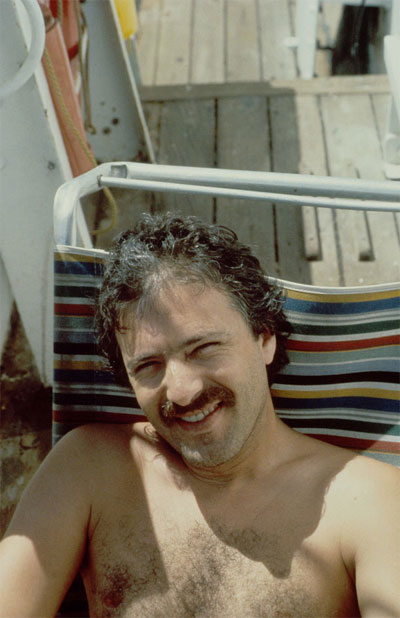
As it emerged that the bombing was a deliberate act of sabotage, there was little doubt in Greenpeace minds who was responsible. Two days after the bombing the French Embassy in Wellington issued a statement echoing the flat denials emanating from Paris. 'In no way is France involved,' it declared. 'The French Government doesn't deal with its opponents in such ways.' But within a few days police had arrested French secret service agents Alain Mafart and Dominique Prieur as they tried to return their van to an Auckland hire company. While they were held in custody, the charter yacht Ouvea, carrying another team of agents implicated in the bombing, sailed to Norfolk Island and then disappeared a few days out to sea heading north for Tahiti. Her crew was reportedly picked up by the French nuclear submarine Rubis, which turned up in Tahiti on July 22, 1985 - the first time a French nuclear submarine had been known to enter the South Pacific.
The international outcry pressured the French Government into setting up its own inquiry. After less than three weeks the head of the inquiry, Bernard Tricot, a former Director-General of the Elysee Palace, announced, 'On the basis of the information available to me at this time, I do not believe there was any French responsibility.' The French agents caught in New Zealand were merely there to spy on Greenpeace, Tricot implied, not to bomb them.
Hostility towards the French Government grew after President Mitterrand threatened that any protesters at Moruroa that year would be arrested, and refused to meet with Greenpeace International director, David McTaggart. Rather than cool the growing international controversy, the transparently inadequate Tricot report served only to fuel the fires of indignation and further undermine the French Government's credibility, so that a second inquiry was ordered on September 5, but it was already too late.
Following claims in the London Sunday Times that President Mitterrand had known of the bombing plan, and implicitly, therefore had authorised it, French Defence Minister Charles Hernu resigned and Admiral Pierre Lacoste, director of the Direction Générale de la Sécurité Extérieure (DGSE), France's intelligence and covert action bureau, was sacked. Within days Prime Minister Fabius admitted French secret service agents had bombed the Rainbow Warrior under orders. It was, said New Zealand Prime Minister David Lange, nothing more than 'a sordid act of international state-backed terrorism'.
Charged with murder and arson, on November 4, 1985 Mafart and Prieur, just two of a much larger team of saboteurs, pleaded guilty in the High Court at Auckland to lesser charges of manslaughter and willful damage and were each sentenced to ten years' imprisonment. Their guilty plea ensured that the facts of the police investigation would never be made public. In June 1986, in a political deal presided over by the United Nations Secretary-General, Javier Perez de Cuellar, France agreed to pay compensation of NZ$13 million (US$6.5 million) to New Zealand and 'apologise', in return for which Mafart and Prieur would be detained at the French military base on Hao atoll for three years.
To cap it all, the two spies were both free by May 1988, after less than two years had elapsed, Mafart having been smuggled out.
Excerpts from Making Waves - the Greenpeace New Zealand Story by Michael Szabo
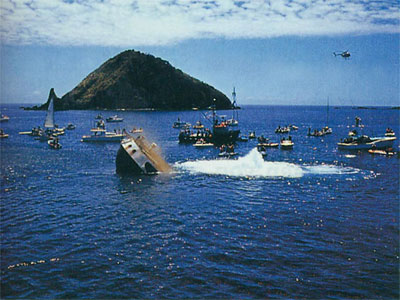
The Rainbow Warrior was scuttled off the island of Motutapere on December 2, 1987 to serve as dive wreck and fish sanctuary after being refloated for a forensic examination.
On the twentieth anniversary of the sinking, it was revealed that the French president François Mitterrand had personally authorised the bombing. Admiral Pierre Lacoste made a statement saying Pereira's death weighed heavily on his conscience.
Editor's Note: It has come to our attention that some dates from the Rainbow Warrior Wikipedia article do not match dates (for the same events) found in Michael Szabo's Making Waves - the Greenpeace New Zealand Story. No modifications were made to the dates from Michael Szabo's book.
By Frisbee Jackson

Sitting in a clichéd "American" restaurant I notice an older employee, late 40's, as he gently brushes the vegetables from the salad arrangement that have gone askew into a small plastic tub for disposal. The hotshot twenty-something comes with his blonde-streaked hair gelled into interesting spikes upon his head.
"Hey! My name's Mark, and I'l be your server tonight. So what are you ladies having?" he asks with a huge grin on his clean shaven face. I'm too busy watching Mr. Salad Bar to notice.
"I'll have the Great American Cheeseburger, and my friend will have a steak with a side of mashed potatoes." my friend replies politely.
"Alright," he says while he quickly jots down the order. "And can I get you guys anything to drink?"
I snap out of my momentary daze. "Uhh, just a water please." My friend asks for the same. The waiter quickly whisks up our menus and flashes us another I-just-started-using-those-Crest-Whitestripes-and-they've-been-working great smile. I can almost see the pocket where he keeps his tips in.
"Do you think he has a wife, or kids?" I ask my friend wistfully, as I resume my people watching. She turns around and slides down the pleather booth for a better look.
"Um...sure, I guess."
"I feel bad for him. I bet his wife left him."
A woman dressed in a crisp pant suit grabs one of the small porcelain plates and attempts to be as graceful as possible as she uses the tongs to transport the broccoli onto her plate. The salad man hurriedly shifts to the other end of the bar, as not to be in the woman's way.
"Wow, and you can tell this just by looking at the dude? I think you and Ms. Cleo need to get together," my friend, thick with sarcasm, says. Now we're both staring straight at him, trying to be as inconspicuous as possible, but failing miserably.
"No, it's just. He looks so sad."
The Salad Bar man replenishes the supply of those delicious little cherry tomatoes, and gives the ranch dressing a stir.
I sigh.
"Yes, and his sadness is just so apparent by the way he handles the wilted lettuce? C'mon now. You can't always feel sorry for everyone. You don't even know the guy."
"Yeah, I guess," I shrug.
The waiter comes with our food and we eat and it's a lovely meal la de da. As we leave, I give Mr. Salad Bar a big smile. And after a slightly confused face, I get a sheepish one back. And then it's on to the cubed ham.
